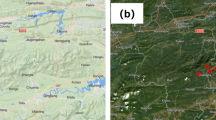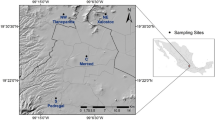Abstract
The relationship between PM2.5 concentration and typical metal elements around a uranium deposit in eastern China was analyzed. The correlation between PM2.5 concentration and metal content in PM2.5 is generally poor, while the correlation between metal elements is generally good. The analysis shows that PM2.5 concentration and U content show the same trend with seasonal replacement, and Th content has a positive correlation with PM2.5 concentration on the whole. PM2.5 concentration was positively correlated with the content of Pb, Cd and Al. There is no obvious relationship between PM2.5 concentration and Ti content, and other theoretical explanations need to be studied.









Similar content being viewed by others
References
Antunes SC, Pereira R, Marques SM et al (2011) Impaired microbial activity caused by metal pollution: a field study in a deactivated uranium mining area. Sci Total Environ 410:87–95
Neiva AMR, Antunes I, Carvalho PCS et al (2016) Uranium and arsenic contamination in the former Mondego Sul uranium mine area, Central Portugal. J Geochem Explor 162:1–15
Pereira R, Marques CR, Ferreira MJS et al (2009) Phytotoxicity and genotoxicity of soils from an abandoned uranium mine area. Appl Soil Ecol 42(3):209–220
Neiva AMR, Carvalho PCS, Antunes I et al (2014) Contaminated water, stream sediments and soils close to the abandoned Pinhal do Souto uranium mine, central Portugal. J Geochem Explor 136:102–117
Neves MO, Figueiredo VR, Abreu MM (2012) Transfer of U, Al and Mn in the water–soil–plant (Solanum tuberosum L.) system near a former uranium mining area (Cunha Baixa, Portugal) and implications to human health. Sci Total Environ 416:156–163
Neiva AMR, de Carvalho PCS, Antunes IMHR et al (2016) Spatial variability of soils and stream sediments and the remediation effects in a Portuguese uranium mine area. Geochemistry 76(4):501–518
Haakonde T, Yabe J, Choongo K et al (2021) Uranium contamination of milk from cattle in the uranium-mining area in Siavonga District of Zambia: a preliminary human health risk assessment. Bull Natl Res Centre 45(1):1–10
Wang Z, Qin H, Liu X (2019) Health risk assessment of heavy metals in the soil-water-rice system around the Xiazhuang uranium mine, China. Environ Sci Pollut Res 26(6):5904–5912
Wisłocka M, Krawczyk J, Klink A, et al (2006) Bioaccumulation of heavy metals by selected plant species from uranium mining dumps in the Sudety Mts., Poland. Pol J Environ Stud 15(5):811–818
Jing CX, Kong QM, Feng ZG (2020) Heavy metal pollution in a uranium mining and metallurgy area in South China. China Environ Sci 40(1):338–349
Gonzalez-Maddux C, Marcotte A, Upadhyay N et al (2014) Elemental composition of PM2.5 in Shiprock, New Mexico, a rural community located near coal–burning power plants and abandoned uranium mine tailings sites. Atmos Pollut Res 5(3):511–519
Rodríguez-Urrego D, Rodríguez-Urrego L (2020) Air quality during the COVID-19: PM2.5 analysis in the 50 most polluted capital cities in the world. Environ Pollut 266:115042
Lu Z, Liu Z (2018) Pollution characteristics and risk assessment of uranium and heavy metals of agricultural soil around the uranium tailing reservoir in Southern China. J Radioanal Nucl Chem 318(2):923–933
Chen L, Wang J, Beiyuan J et al (2021) Environmental and health risk assessment of potentially toxic trace elements in soils near uranium (U) mines: a global meta-analysis. Sci Total Environ 816:151556
Shi S, Tang X, Yang Y et al (2021) Biological effects of uranium in water, soil and rice in uranium deposits in southern China. J Radioanal Nucl Chem 328(2):507–517
Purchase R (2013) The link between copper and Wilson’s disease. Sci Prog 96(3):213–223
Bates JT, Weber RJ, Abrams J et al (2015) Reactive oxygen species generation linked to sources of atmospheric particulate matter and cardiorespiratory effects. Environ Sci Technol 49(22):13605–13612
Wang F, Zhou Y, Meng D et al (2018) Heavy metal characteristics and health risk assessment of PM2.5 in three residential homes during winter in Nanjing, China. Build Environ 143:339–348
Liu Y, Xing J, Wang S et al (2018) Source-specific speciation profiles of PM2.5 for heavy metals and their anthropogenic emissions in China. Environ Pollut 239:544–553
Wang W, Luo X, Wang Z et al (2018) Heavy metal and metalloid contamination assessments of soil around an abandoned uranium tailings pond and the contaminations’ spatial distribution and variability. Int J Environ Res Public Health 15(11):2401
Kermani M, Farzadkia M, Kalantari RR et al (2018) Fine particulate matter (PM2.5) in a compost facility: heavy metal contaminations and health risk assessment, Tehran, Iran. Environ Sci Pollut Res 25(16):15715–15725
Wang Z, Qin H, Wang J (2019) Accumulation of uranium and heavy metals in the soil–plant system in Xiazhuang uranium ore field, Guangdong Province, China. Environ Geochem Health 41(6):2413–2423
Salbu B, Burkitbaev M, Strømman G et al (2013) Environmental impact assessment of radionuclides and trace elements at the Kurday U mining site, Kazakhstan. J Environ Radioact 123:14–27
Pinto M, Silva M, Neiva AMR (2004) Pollution of water and stream sediments associated with the Vale de Abrutiga uranium mine, Central Portugal. Mine Water Environ 23(2):66–75
Neves MO, Matias MJ, Basto MJ, et al (2005) Abandoned mine site characterization for remediation: the case of the Cunha Baixa uranium mine (Viseu, Portugal), pp 159–169
Bagheri R, Bagheri F, Karami GH et al (2019) Chemo-isotopes (18O & 2H) signatures and HYSPLIT model application: Clues to the atmospheric moisture and air mass origins. Atmos Environ 215:116892
Pirouzmand A, Kowsar Z, Dehghani P (2018) Atmospheric dispersion assessment of radioactive materials during severe accident conditions for Bushehr nuclear power plant using HYSPLIT code. Prog Nucl Energy 108:169–178
Bilińska D, Skjøth CA, Werner M et al (2017) Source regions of ragweed pollen arriving in south-western Poland and the influence of meteorological data on the HYSPLIT model results. Aerobiologia 33(3):315–326
Liu P, Ren H, Xu H et al (2018) Assessment of heavy metal characteristics and health risks associated with PM2.5 in Xi’an, the largest city in northwestern China. Air Qual Atmos Health 11(9):1037–1047
Haakonde T, Yabe J, Choongo K et al (2020) Preliminary assessment of uranium contamination in drinking water sources near a uranium mine in the Siavonga District, Zambia, and associated health risks. Mine Water Environ 39(4):735–745
Farsani MH, Shirmardi M, Alavi N et al (2018) Evaluation of the relationship between PM10 concentrations and heavy metals during normal and dusty days in Ahvaz, Iran. Aeol Res 33:12–22
Dushenkov S, Vasudev D, Kapulnikn Y et al (1997) Removal of uranium from water using terrestrial plants. Environ Sci Technol 31(12):3468–3474
Jiang N, Guo Y, Wang Q et al (2017) Chemical composition characteristics of PM2.5 in three cities in Henan, central China. Aerosol Air Qual Res 17(10):2367–2380
CNEMC. Background Values of Soil Elements in China. Beijing, 1990, pp 334–490
Sharma S, Singh B, Manchanda VK (2015) Phytoremediation: role of terrestrial plants and aquatic macrophytes in the remediation of radionuclides and heavy metal contaminated soil and water. Environ Sci Pollut Res 22(2):946–962
Edition F (2011) Guidelines for drinking-water quality. WHO Chronicle 38(4):104–108
Rocha LDS, Corrêa SM (2018) Determination of size-segregated elements in diesel-biodiesel blend exhaust emissions. Environ Sci Pollut Res 25(18):18121–18129
Men C, Liu R, Wang Q et al (2018) The impact of seasonal varied human activity on characteristics and sources of heavy metals in metropolitan road dusts. Sci Total Environ 637:844–854
Jung J, Ghim YS, Lyu YS et al (2019) Quantification of regional contributions to fine particles at downwind areas under Asian continental outflows during winter 2014. Atmos Environ 210:231–240
Osada K, Ura S, Kagawa M et al (2014) Wet and dry deposition of mineral dust particles in Japan: factors related to temporal variation and spatial distribution. Atmos Chem Phys 14(2):1107–1121
Acknowledgements
This research was funded by the National Natural Science Foundation of China (22266004, 11875105, 21866006).
Author information
Authors and Affiliations
Corresponding author
Additional information
Publisher's Note
Springer Nature remains neutral with regard to jurisdictional claims in published maps and institutional affiliations.
Rights and permissions
Springer Nature or its licensor (e.g. a society or other partner) holds exclusive rights to this article under a publishing agreement with the author(s) or other rightsholder(s); author self-archiving of the accepted manuscript version of this article is solely governed by the terms of such publishing agreement and applicable law.
About this article
Cite this article
Shi, S., Huang, M., Li, X. et al. Correlation analysis between typical metal elements and PM2.5 in a uranium tail mining area in East China. J Radioanal Nucl Chem 332, 2159–2166 (2023). https://doi.org/10.1007/s10967-023-08816-5
Received:
Accepted:
Published:
Issue Date:
DOI: https://doi.org/10.1007/s10967-023-08816-5




